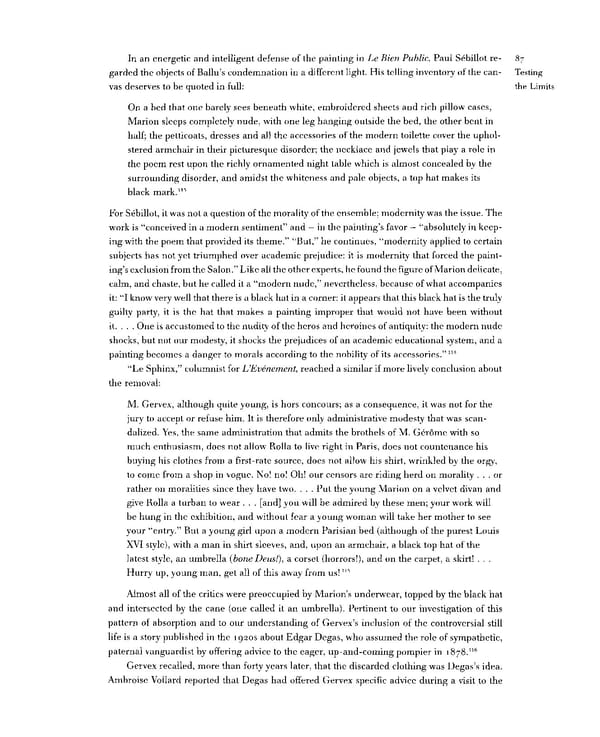In an energetic and intelligent defense of the painting in Le Bien Public, Paul Sebillot re- 87 garded the objects of Ballu's condemnation in a different light. His telling inventory of the can- Testing vas deserves to be quoted in full: the Limits On a bed that one barely sees beneath white, embroidered sheets and rich pillow cases, Marion sleeps completely nude, with one leg hanging outside the bed, the other bent in half; the petticoats, dresses and all the accessories of the modern toilette cover the uphol- stered armchair in their picturesque disorder; the necklace and jewels that play a role in the poem rest upon the richly ornamented night table which is almost concealed by the surrounding disorder, and amidst the whiteness and pale objects, a top hat makes its 113 black mark. For Sebillot, it was not a question of the morality of the ensemble; modernity was the issue. The work is "conceived in a modern sentiment" and — in the painting's favor — "absolutely in keep- ing with the poem that provided its theme." "But," he continues, "modernity applied to certain subjects has not yet triumphed over academic prejudice: it is modernity that forced the paint- ing's exclusion from the Salon." Like all the other experts, he found the figure of Marion delicate, calm, and chaste, but he called it a "modern nude," nevertheless, because of what accompanies it: "I know very well that there is a black hat in a corner: it appears that this black hat is the truly guilty party, it is the hat that makes a painting improper that would not have been without it. ... One is accustomed to the nudity of the heros and heroines of antiquity: the modern nude shocks, but not our modesty, it shocks the prejudices of an academic educational system, and a painting becomes a danger to morals according to the nobility of its accessories."114 "Le Sphinx," columnist for UEvenement, reached a similar if more lively conclusion about the removal: M. Gervex, although quite young, is hors concours; as a consequence, it was not for the jury to accept or refuse him. It is therefore only administrative modesty that was scan- dalized. Yes, the same administration that admits the brothels of M. Gerome with so much enthusiasm, does not allow Rolla to live right in Paris, does not countenance his buying his clothes from a first-rate source, does not allow his shirt, wrinkled by the orgy, to come from a shop in vogue. No! no! Oh! our censors are riding herd on morality ... or rather on moralities since they have two. . . . Put the young Marion on a velvet divan and give Rolla a turban to wear . . . [and] you will be admired by these men; your work will be hung in the exhibition, and without fear a young woman will take her mother to see your "entry." But a young girl upon a modern Parisian bed (although of the purest Louis XVI style), with a man in shirt sleeves, and, upon an armchair, a black top hat of the latest style, an umbrella (bone Deus!}, a corset (horrors!), and on the carpet, a skirt! . . . Hurry up, young man, get all of this away from us!115 Almost all of the critics were preoccupied by Marion's underwear, topped by the black hat and intersected by the cane (one called it an umbrella). Pertinent to our investigation of this pattern of absorption and to our understanding of Gervex's inclusion of the controversial still life is a story published in the 19208 about Edgar Degas, who assumed the role of sympathetic, paternal vanguardist by offering advice to the eager, up-and-coming pompier in iS/S.116 Gervex recalled, more than forty years later, that the discarded clothing was Degas's idea. Ambroise Vollard reported that Degas had offered Gervex specific advice during a visit to the
 Prostitution & Impressionists Page 107 Page 109
Prostitution & Impressionists Page 107 Page 109